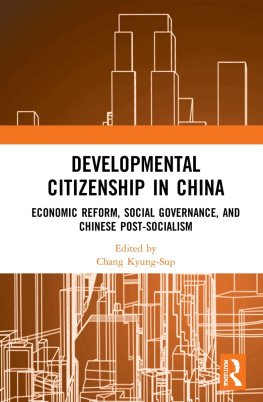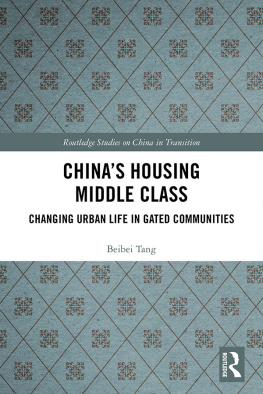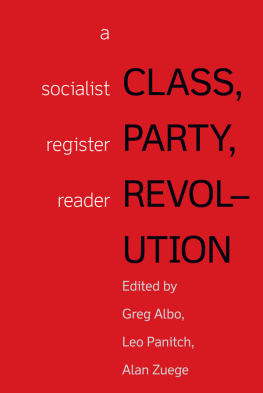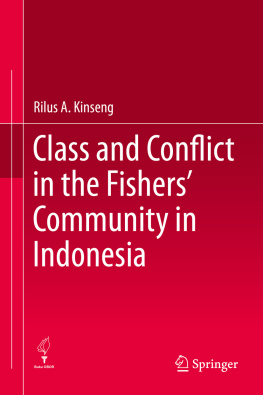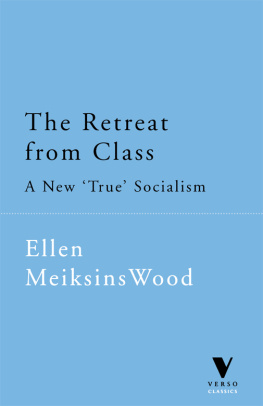New York Columbia University Press 1981
Library of Congress Cataloging in Publication Data
Kraus, Richard Curt.
Class Conflict in Chinese Socialism.
(Studies of me Bast Asian Institute)
Includes bibliographical references and index.
1. Social classes China. 2. Social conflict. 3. Social structure. 4. Communism China. I. Title. II. Series.
HN740.Z9S63 305.50951 81-7754
ISBN 0-231-05182-4 AACR2
Copyright 1981 Columbia University Press
All rights reserved.
Printed in the United States of America
Columbia University Press
New York Guildford, Surrey
Clothbound editions of Columbia University Press books are Smyth-sewn and printed on permanent and durable acid-free paper.
epub version 1.0
The East Asian Institute of Columbia University
The East Asian Institute of Columbia University was established in 1949 to prepare graduate students for careers dealing with East Asia, and to aid research and publication on East Asia during the modern period. The faculty of the Institute are grateful to the Ford Foundation and the Rockefeller Foundation for their financial assistance.
The Studies of the East Asian Institute were inaugurated in 1962 to bring to a wider public the results of significant new research on modern and contemporary East Asia.
Preface
In the course of its protracted struggle for power, the Chinese Communist Party developed a deep concern for social inequality, elaborating both programs and institutions to mobilize the support of the impoverished and oppressed against the wealthy classes which provided support for its enemies. This book explores the fate of this revolutionary commitment to class struggle in the generation since the establishment of the Peoples Republic of China in 1949.
Within socialist China, the interpretation of class conflict has been a question of bitter, sometimes violent controversy. Neither the Marxist classics nor the prior experience of the Soviet Union have provided decisive answers to such fundamental questions as when recently dispossessed ruling classes could be said no longer to exist; the nature of the relationship of workers, peasants, and intellectuals to the new socialist state; and how the officials of this state are related to the rest of society. The practical ramifications of such issues are so clearly important that their discussion has never been detached and academic, but rather has been embedded within serious political and social struggles over what kind of society China should be. To put the matter sharply, class analysis in China is an aspect of the class conflict it is intended to comprehend.
As an example, consider the awkward new assessment by the Communist Party of its former Chairman, Mao Zedong. In the view of his successors, who seek to borrow Maos prestige while sanitizing his ideas, among the late Chairmans most bothersome errors was that he saw conflict among classes where it (and they) did not exist. From this class analysis, Mao concluded that an old revolutionary ought to advocate a radical program to limit the sources of privilege and to consolidate the material benefits available to the working masses. A contrary analysis, at one time entertained by Mao and still advanced by Deng Xiaoping and his circle, is that class conflict, save for a few noisy echoes, was put on its way out of China with the creation of socialist institutions in 1956. If indeed state control of productive assets assures a minor role for class conflict, then Maos radical activism rested upon a false basis, and needlessly disrupted a society which already had settled the class issue.
I am keenly aware that my analysis does not always capture the subtlety of Chinese discussions of the question of class. Nor does my academic prose adequately represent either the grandeur or the sordidness of the struggles which I describe. Failures of insight and style, as well as any factual errors which may remain in the text, are my own, and should not be attributed to the institutions and individuals whose assistance I have enjoyed. These include Columbia Universitys East Asian Institute and Research Institute on International Change; the Universities Service Centre of Hong Kong; and the Department of Sociology, Center for Asian Studies, and Graduate College of the University of Illinois. Too many individuals have generously shared their experiences with me to be named here, but I am deeply grateful for information and suggestions offered by friends and colleagues from both China and the West. Among those who have read and commented upon various portions of this study are Thomas Bernstein, Steven Butts, Randall Edwards, Joel Glassman, Steven Levine, Patrick Maddox, Roberta Martin, Andrew Nathan, Michel Oksenberg, William Parish, James Reardon-Anderson, Susan Shirk, Dorothy Solinger, Anne Thurston, and Martin King Whyte.
I have rendered Chinese names and phrases in pinyin romanization throughout this book, except in those cases where I quote English-language publications which have used the older Wade-Giles romanization system.
Richard Curt Kraus
July 1981
Chapter One
Introduction: The Problem of Class in Socialist China
In 1965 in Beijing, Mao Zedong discussed the fate of revolutions with the visiting French Minister of Culture, Andr Malraux. According to Malraux, his host remarked that Humanity left to its own devices does not necessarily reestablish capitalism but it does reestablish inequality. The forces tending toward the creation of new classes are powerful. Mao might have made his point still more forcefully: even when humanity has not been left to its own devices and it has not been in China inequality persists.
Although Chinese socialism has not eradicated inequality, it has altered the forms which it assumes. The most fundamental such alteration has been the restriction of private property, a success of the revolution which gives rise to an apparent paradox in contemporary Chinese society. Leaders of the Chinese Communist Party have frequently characterized their society as one rent by large-scale struggle among classes; yet the property relationships that underlie a conventional Marxist conception of class were essentially destroyed nearly three decades ago, as China socialized its economy. How, then, is one to make sense of the continued use of such terms as bourgeois and landlord in a society where such classes certainly cannot exist as we know them from capitalist experience?
One approach is to presume, as many students of China tacitly do, that the language of class in fact does not make much sense, that it serves primarily as a cloak for self-interest, or that its meaning is so abstruse that it can only arouse pedantic curiosity. Such a view is encouraged by the vagueness of much discussion of class in the Chinese press, where concrete references to social structure are often lacking.
It is dubious, however, that a vocabulary employed so extensively as has been the language of class in China can be merely rhetorical in nature. This language, derived from the Marxist tradition but modified in its new context, became the principal medium for political discourse in the Peoples Republic. Political discussion is often far removed from social analysis, a phenomenon no doubt as true in China as in any other country. But where alternative terminologies are so often considered illegitimate, the language of class must serve as the vehicle for discussions of more serious significance.
Much of the difficulty in grasping the Chinese concept of class stems from the tumult within the society it is intended to analyze. Revolution, then rapid industrialization have compressed a broad range of radical social changes within a single generation. The problem is not that class is without meaning, but that it has come to bear multiple connotations, as competing forces in a rapidly changing society have endeavored to utilize the concept to buttress their own interests. The search for the meaning of class, then, must be made alongside an examination of the changes which have been made in Chinas social structure. Changing Chinese approaches to the class system of the Peoples Republic are themselves elements in the social conflict which they prescribe, illuminate, and obscure. Little progress in extending our comprehension either of Chinese social tensions or of systematic self-representations by the Chinese of their society is possible without appreciating the complex interaction of theories of class with the practice of social inequality in which these theories are embedded.
Next page



